Lonicera sempervirens, commonly called trumpet honeysuckle, is a vigorous, deciduous, twining vine which typically grows 10-15' (less frequently to 20') and is one of the showiest of the vining honeysuckles. It is primarily native to the southeastern U.S., but has escaped from gardens and naturalized in many other areas of the eastern U.S. including several counties in central and southern Missouri where it typically occurs along roadsides, along stream banks and in thickets (see Steyermark).
Lonicera Sempervirens Care
Lonicera Sempervirens



How to Care for the Plant

Water

Don't water the leaves, as damp foliage encourages plant diseases. Try watering with a soaker hose for the best results. If the vines develop powdery mildew, apply a fungicide. For best growth, keep Japanese honeysuckle well watered (1 inch per week) and protect the soil with a layer of bark mulch. If the plant becomes too dry, leaves will turn brown and fall off, though the vine itself rarely dies.

Pruning

These should be pruned back in mid to late summer as soon as they finish flowering, cut them back by around one third to healthy new growth, just under the flowering growth. At the same time remove any dead, diseased or damaged growth.

Fertilizer

Apply a balanced 10-10-10 all-purpose fertilizer in spring when the honeysuckle starts to produce new growth. Use 1 tablespoon of 10-10-10 fertilizer for every 1 foot of height of your honeysuckle. For example, a 3-foot-tall honeysuckle should receive 3 tablespoons of fertilizer.

Sunlight

Will grow in some shade, but best flowering is in full sun.

Soil

Easily grown in average, medium moisture, well-drained soils.

Temperature

Plants are very hardy, tolerating temperatures down to -15°c or lower, though they can be deciduous in cold winters.

Popularity

1,304 people already have this plant 125 people have added this plant to their wishlists
Discover more plants with the list below
Popular articles






